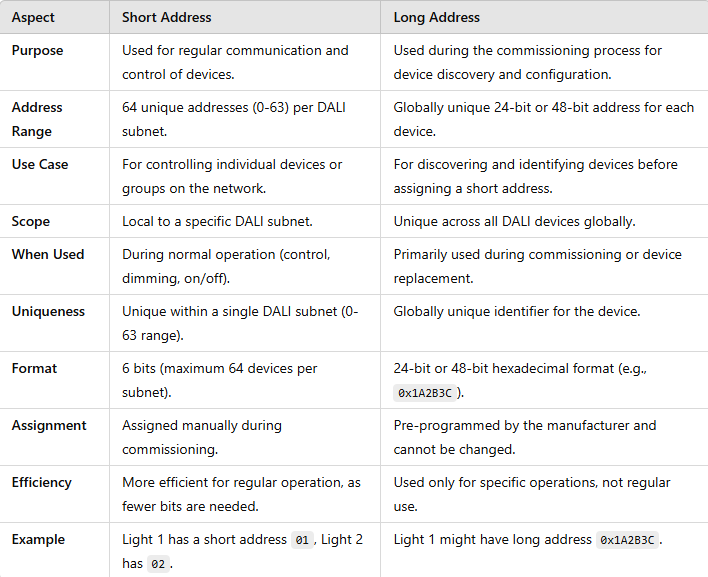
What is Short Address and Long Address in DALI
In DALI systems, short addresses and long addresses are used to identify devices or groups of devices for control and communication purposes. Here’s a breakdown of the key differences
1. Short Address
A short address is a unique identifier for individual devices within a DALI subnet. It allows a central controller to communicate with each device individually. Short addresses are commonly used in DALI networks to control lighting fixtures and other devices.
Key Characteristics of Short Addresses:
- Range: DALI systems allow up to 64 short addresses per subnet (ranging from 0 to 63), meaning you can have a maximum of 64 devices on a single DALI bus.
- Uniqueness: Each device on a DALI network must have a unique short address within its subnet.
- Device Identification: Short addresses are used to send commands to a specific device. For example, if you want to turn off or dim a light, you use its short address.
- Direct Communication: When a command is sent using a short address, it is sent directly to the specific device associated with that address.
- Configuration: The short address is assigned during the commissioning process using a DALI controller or software. This address allows for point-to-point control of devices.
Example of Short Address Use:
- In an office building with 64 DALI-enabled lights, each light could have a short address between 0 and 63. The controller can send commands to individual lights (e.g., dim light at address 10 to 50%).
2. Long Address
A long address is a globally unique identifier for each device, typically used during the commissioning phase for initial device discovery, addressing, and management. Long addresses allow devices to be uniquely identified across all DALI systems and are used to configure devices before they are assigned a short address.
Key Characteristics of Long Addresses:
- Uniqueness: The long address is globally unique and specific to each device, which ensures that devices can be identified even before they are assigned a short address.
- Hexadecimal Format: Long addresses are usually 24-bit or 48-bit hexadecimal identifiers, providing a much larger range of unique addresses compared to short addresses.
- Use During Commissioning: Long addresses are primarily used during the commissioning process, where devices are discovered, identified, and then assigned a short address for normal operation.
- Temporary Use: Once the device has been assigned a short address, the long address is no longer used in regular operation. However, it can still be useful for device replacement or network diagnostics.
- Device Replacement: If a device fails and needs to be replaced, the long address can be used to identify the new device and assign the same short address to ensure continued functionality without reprogramming the entire system.
Example of Long Address Use:
- During commissioning, a controller scans the DALI network to discover devices based on their long addresses. It then assigns short addresses (0-63) to each device. A DALI light might have a long address like 0x1A2B3C, but after commissioning, it is referred to by its short address 05 for normal operation.

